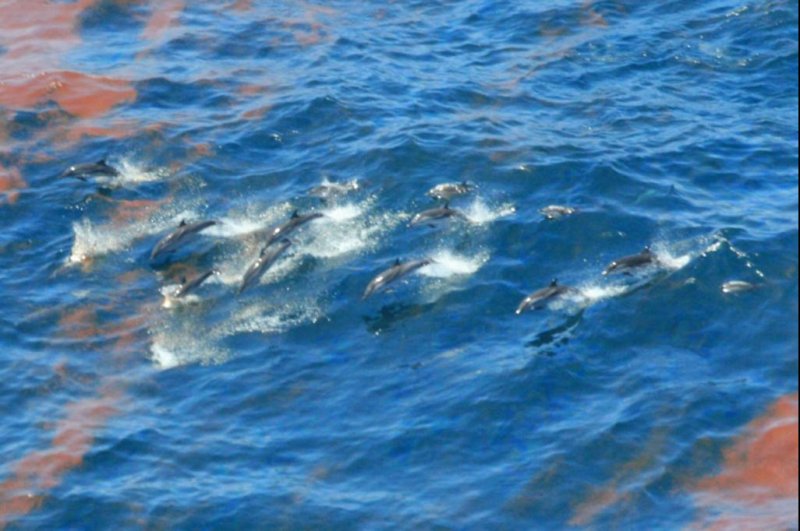Dolphins seen swimming through an oil sheen in the Gulf of Mexico in 2011. Photo by NOAA
BARATARIA BAY, La., May 20 (UPI) -- A new study by the NOAA concludes that the 2011 BP oil spill, the largest marine-based oil spill in U.S history, is to blame for the ongoing die-off of bottlenose dolphins in the northern Gulf of Mexico.
The new paper -- authored by 22 scientists as part of unusual mortality event investigation by the NOAA -- confirms the conclusions of a number of other studies. The research validates the findings of a 2011 study that showed live dolphins in Louisiana's Barataria Bay suffered poor health, adrenal disease, and lung disease linked to contaminants from the Deepwater Horizon oil spill.
"This is the latest in a series of peer-reviewed scientific studies, conducted over the five years since the spill, looking at possible reasons for the historically high number of dolphin deaths that have occurred within the footprint of the Deepwater Horizon spill," said study author Dr. Teri Rowles, veterinarian and head of NOAA's Marine Mammal Health and Stranding Response Program.
"These studies have increasingly pointed to the presence of petroleum hydrocarbons as being the most significant cause of the illnesses and deaths plaguing the Gulf's dolphin population," Rowles said. "This study carries those findings significantly forward."
The latest findings build on the the 2011 Barataria Bay study. In examining dead dolphins in and around the Louisiana bay -- one of the areas most contaminated by spilled oil -- between June 2010 and November 2012, researchers found nearly half of all specimens had a thinning adrenal gland cortex.
Contaminants from oil are proven to damage adrenal glands, and adrenal insufficiency can make sea mammals susceptible to a range of other diseases and stressors.
Scientists also found that a third of all deceased dolphins collected and examined across Louisiana, Mississippi and Alabama had lung lesions consistent with oil contamination. Only 7 percent of the dead or stranded dolphins from non-oil spill areas showed signs of a thinning adrenal cortex, and only 2 percent had lung lesions.
"These dolphins had some of the most severe lung lesions I have seen in the over 13 years that I have been examining dead dolphin tissues from throughout the United States," said Dr. Kathleen Colegrove, a researcher at the University of Illinois and lead veterinary pathologist during the multi-year study.
The new study was published this week in the journal PLOS ONE.















